Displaying items by tag: Jeremy Irons
It’s not every day you’re helped aboard a new boat by an international star of stage and screen writes W M Nixon. But it happened at the weekend in Baltimore, where A-list actor Jeremy Irons is now a quietly familiar part of the West Cork summer scene, and particularly the traditional and classic boat side of it.
So much so, in fact, that it would be unusual for an event such as last weekend’s Baltimore Woodenboat & Seafood Festival if this most noted of their local skippers didn’t sally forth to participate from his restored Kilcoe Castle, which is just round the corner on the shores of Roaringwater Bay.
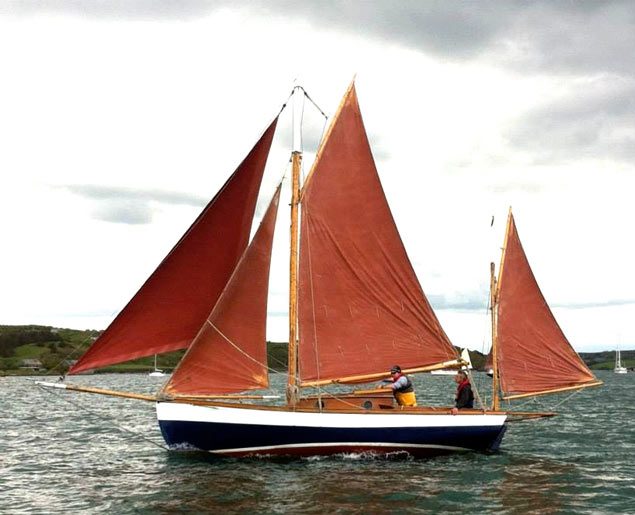 The pet boat. Jeremy Irons’ own sailing pride-and-joy in West Cork is the Willing Lass. As to her rig, the talk might go on all night as to whether she’s a ketch or a yawl.
The pet boat. Jeremy Irons’ own sailing pride-and-joy in West Cork is the Willing Lass. As to her rig, the talk might go on all night as to whether she’s a ketch or a yawl.
For those unfamiliar with the area, we hasten to say that the bay is named for the Roaringwater River which flows into it – Kilcoe Castle stands above reasonably serene waters, in the heart of an island-studded area where bustling Baltimore is within easy reach.
It was certainly beginning to bustle when the Ilen Boat-Building School of Limerick’s caravanserai – for no other word more aptly fills the bill – finally arrived in Baltimore with their eclectic collection of boats in tow or on trucks. And it was good to see that, as the larger fleet took up their berths at the harbour, there beside the quay was the familiar friendly shape of Jeremy Irons’ own little classic yawl, Willing Lass.
While the Ilen people had brought their usual range of Shannon gandelows and other craft, their little fleet in Baltimore included three dinghies of the Valentine Punt type, which originates from a 10ft punt built in 1926 at Passage West on Cork Harbour as a tender for John Valentine Sisk. His grandson Hal Sisk remembered so vividly the little boat’s wellnigh-perfect rowing ability, and her stability with remarkable load-carrying power, that he has made kits available to re-create the Valentine Punt in a much lighter Epoxy-built edge-glued version, which retains the use of clinker marine ply planks, but doesn’t require frames.
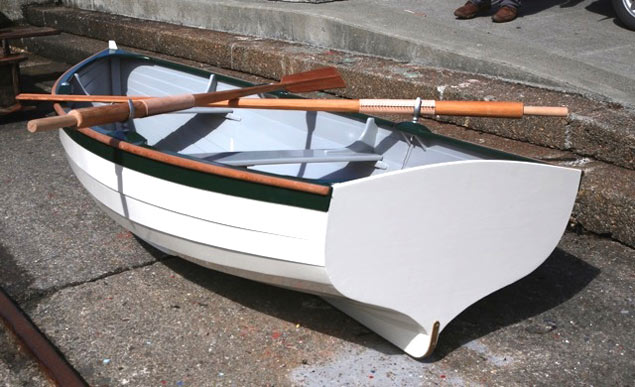 In honour of trainee boatbuilder Elan Broadley’s home county, the final touch of perfection for the new punt has been a Donegal green sheerstrake. Photo: Gary MacMahon
In honour of trainee boatbuilder Elan Broadley’s home county, the final touch of perfection for the new punt has been a Donegal green sheerstrake. Photo: Gary MacMahon
The Ilen Boat-Building School is always on the lookout for interesting new projects, so he donated one of the kits to its Limerick premises, and the job of building the boat was under-taken as a solo project by Elan Broadley from Donegal, with the school’s teacher Matt Dirr revealing his talents as a light-handed instructor.
For the young Donegal man, it was a lengthy and sometimes difficult process. But when the resulting 10ft punt was brought to the slip in Baltimore as the weather improved to a briskly sunny day on Saturday, it all became thoroughly worthwhile. The little boat simply looked a treat, the final perfection being a sheerstrake of Donegal green in honour of the builder.
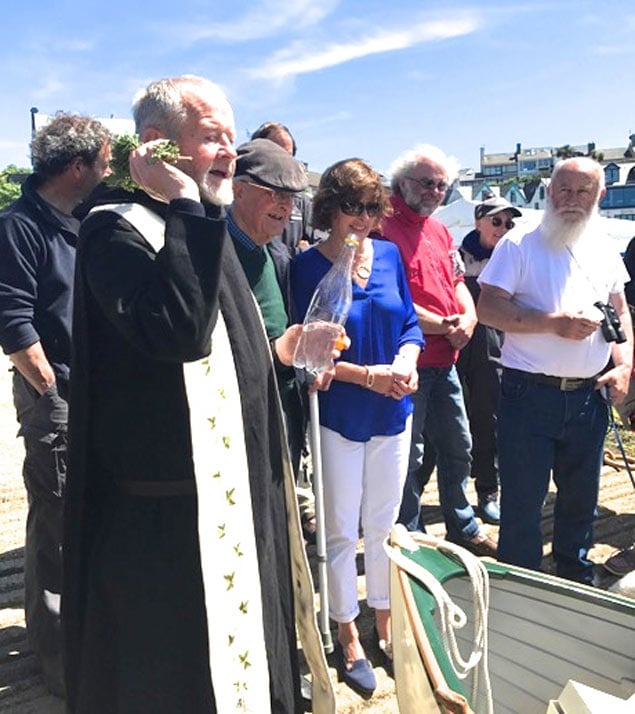 Brother Anthony of Glenstal Abbey blesses the new boat, assisted by Richard Bushe. Photo: Gary MacMahon
Brother Anthony of Glenstal Abbey blesses the new boat, assisted by Richard Bushe. Photo: Gary MacMahon
Elan’s mother Geraldine had come down from Donegal for this very special occasion, while Hal Sisk had come from Dun Laoghaire and leading traditional boat enthusiasts such as Paddy Barry had also travelled to be there with folk like Mary Jordan who keep the Baltimore Woodenboat show on the road, and it became one of those informal gatherings which somehow acquires its own momentum.
The boat was blessed by Brother Anthony Keane from Glenstal Abbey, who is a Director of the Ilen Boat-Building School, assisted by Richard Bushe on behalf of the Baltimore maritime community. A very special cake, dedicated to Hal and Matt, was ceremoniously sliced and consumed with enthusiasm, and then after the two other Valentine Punts had been sent off to row about in the inner harbour as a welcoming escort, the new boat took to the water for the first time.
 A very special cake gave thanks from Elan Broadley to Hal Sisk, the donor of the boat-building kit, and Matt Dirr the Ilen School Instructor. Photo: Gary MacMahon
A very special cake gave thanks from Elan Broadley to Hal Sisk, the donor of the boat-building kit, and Matt Dirr the Ilen School Instructor. Photo: Gary MacMahon
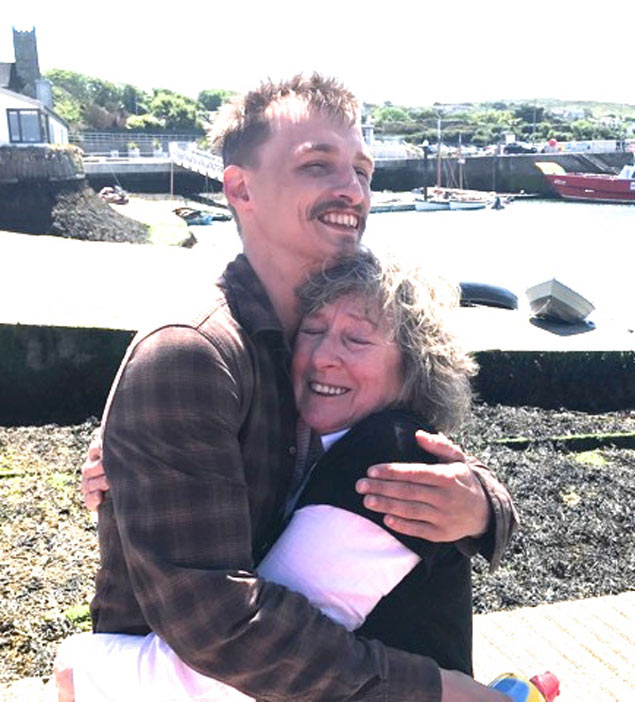 “Well done!” Mary Jordan of the Baltimore Woodenboat & Seafood Festival gives her warmest approval to Elan Broadley for his efforts. Photo: Gary MacMahon
“Well done!” Mary Jordan of the Baltimore Woodenboat & Seafood Festival gives her warmest approval to Elan Broadley for his efforts. Photo: Gary MacMahon
It was now that Hal Sisk reckoned he’d the perfect opportunity to demonstrate the Valentine Punt’s excellent load-carrying capacity, and somehow Jeremy Irons – who has long taken a close interest in the Ilen project – was roped in to help people aboard and send a worthwhile payload afloat. Like the good trouper he is, he threw himself into the role with relish, and the new dinghy – with Hal himself doing the rowing from the useful bow position – showed she could confidently carry six people, including the young boat-builder’s mother.
 Always a willing trouper – Jeremy Irons enthusiastically took on he role of quayside attendant and boat loader
Always a willing trouper – Jeremy Irons enthusiastically took on he role of quayside attendant and boat loader
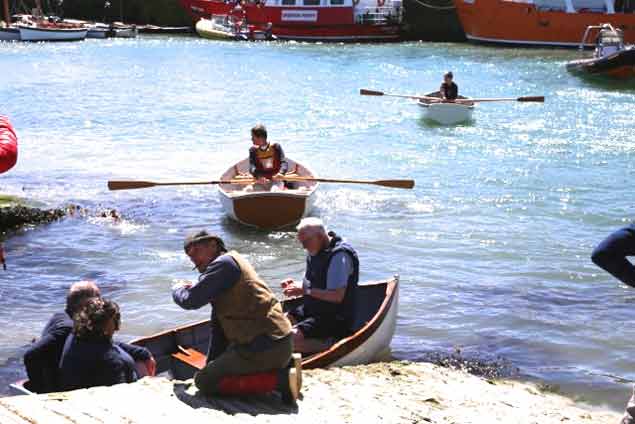 “Come on, there’s plenty of room for lots more......” Jeremy Irons piling them in, while the two sister-punts row out into the harbour. Photo: Gary MacMahon
“Come on, there’s plenty of room for lots more......” Jeremy Irons piling them in, while the two sister-punts row out into the harbour. Photo: Gary MacMahon
It’s not every day that you can travel all the way from Donegal to West Cork to see the first boat built by your son being launched in front of such an extraordinary and approving group. And then to be helped on board that same boat by a real international superstar successfully pretending to be a quayside attendant....well, it made Geraldine’s day.
In fact, it made everyone’s day. In this one charming little launching ceremony, the message of hope which is embodied in the Ilen Boat-Building School became clear for all to see, share and understand.
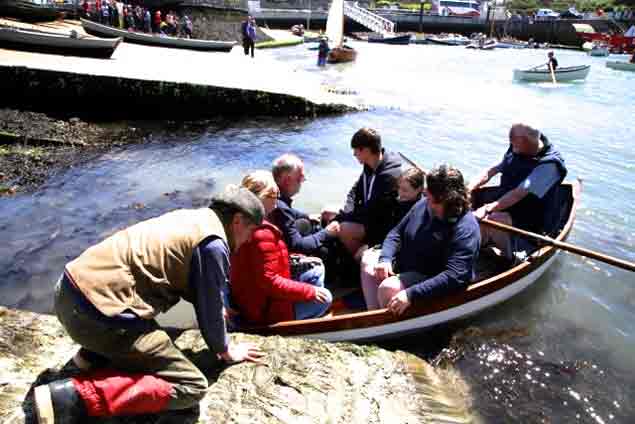 Sending them on their way – with Hal Sisk on the oars, the little punt takes the load. Photo: Gary McMahon
Sending them on their way – with Hal Sisk on the oars, the little punt takes the load. Photo: Gary McMahon
 Job done. Elan’s mother Geraldine (red jacket) floats for the first time in the punt her son built. In the interests of safety, they stayed strictly in the shallowest water, but the little punt carried the load very well. Photo: Gary MacMahon
Job done. Elan’s mother Geraldine (red jacket) floats for the first time in the punt her son built. In the interests of safety, they stayed strictly in the shallowest water, but the little punt carried the load very well. Photo: Gary MacMahon
























































